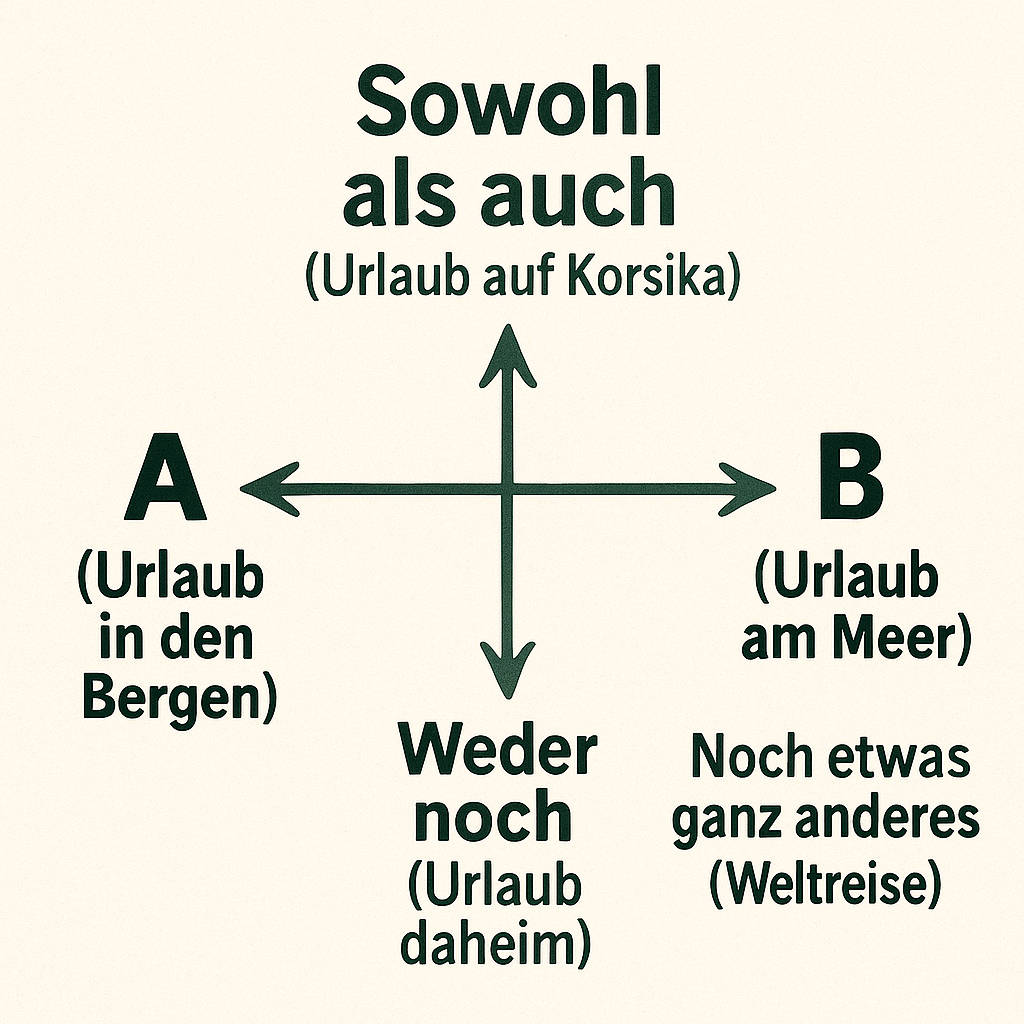“Both” and the Gift of Simultaneity
To pick up the thread from the last post:
Sometimes I long for simple answers.
For solutions to complex problems.
Yes or no. Right or wrong. Either or.
And yet, I’ve long known: That’s not how my life works. That’s not how the world works.
In systemic counseling, there’s a method that beautifully illuminates this dilemma: the tetralemma.
It opens up more than the classic either-or logic.
It reveals four – and sometimes even five – paths, offering unexpected degrees of freedom:
- Either A
- Or B
- Both A and B
- Neither A nor B
- And then: Something entirely different
It sounds simple – and sometimes feels utterly impossible.
Ambivalence has been a loyal companion on my path:
Closeness and security are deeply important to me, while I also long for freedom and independence.
I feel joy in diversity and, at the same time, worry about spreading myself too thin.
I love the openness of new possibilities, and yet I can feel my inner system crying out for calm and stability.
I know both: the relief of making a decision – and the sense of constriction it can bring.
What I’ve learned from a systemic perspective:
Sometimes it’s not about deciding faster.
Sometimes it’s about staying in the insecurity for longer.
Simultaneity is a gift.
And that’s not just a psychological truth – it’s also a physical one.
In the books Polysecure and Polywise, which I had the privilege of translating from English into German, the workings of our attachment system are described beautifully – how our nervous system shifts between states of safety and alarm.
When our system is stressed and tense, our internal playing field shrinks.
We seek clarity, certainty.
We crave (perceived) safety through clear lines.
We judge more quickly, evaluate more harshly, categorize more rigidly.
You see this everywhere – in public discourse, in the news, on social media.
A diffuse sense of overwhelm. Fear of losing control.
The feeling of being left behind or insignificant in a world that seems to grow ever faster, louder, bigger, more complex.
Unconscious comparison and a search for grounding and orientation often result in the division of “us vs. them,” in stereotypes, clichés, and the promises of ideology.
When we’re in a state of stress, we seek affirmation.
And sometimes, even negative affirmation feels good:
“See? I knew it. I’ve been saying it all along…”
A tiny dopamine hit. A fleeting moment of being right.
The more activated our nervous system is, the less we can allow “both” into our awareness.
On the other hand, those who feel safe – in themselves and/or in their surroundings – can tolerate differences and ambivalence more easily.
This ability is known as ambiguity tolerance.
And while outer factors help, inner safety can also be cultivated.
Self-worth can be strengthened. Regulation techniques can be learned.
When I look at my own life, I’m grateful for the positive experiences I’ve had with the “both” – for the gift of simultaneity in emotions and experiences:
- In relationships: It’s not just closeness or distance. There’s in-between, movement, negotiation.
- In parenting: It’s not just freedom or boundaries. There’s guidance and trust, all at once.
- In my work: I’m allowed to be a counselor, a researcher, a podcaster, and an author – all at the same time. Not always perfectly. But fully aligned with who I am.
Sometimes, growth doesn’t mean making a decision.
It means developing the capacity to hold multiplicity.
Maybe that’s the real practice:
Not just searching for answers – but keeping space open.
Not just wanting to be right – but staying curious.
Both.
Neither nor.
And sometimes: Something entirely different.
So glad you’re here. 💛


Leave a Reply